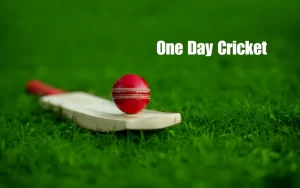Cricket is a sport loved by millions around the world. Among its various formats, One Day International (ODI) cricket stands out for its unique blend of strategy, skill, and excitement. Played over a single day, this format provides both the pace of limited overs and the drama of high-stakes competition. In this article, we’ll examine One Day cricket, exploring its origins, key features, and why it continues to captivate fans worldwide.
What is One Day Cricket?
One-day cricket, commonly referred to as ODI cricket, is a limited-overs format in which each team is allowed a maximum of 50 overs to score as many runs as possible. This format was introduced in the early 1970s to make the game more dynamic and accessible, especially when a multi-day Test match format was impractical. In an ODI match, each team bats once, and the team that scores the most runs wins.
Unlike Test cricket, which can last up to five days, ODI cricket is completed in a single day, typically lasting about 7-8 hours, including a break between innings. This shorter duration makes the game more appealing to a larger audience, especially in the fast-paced modern world where time is of the essence. The introduction of powerplays, fielding restrictions, and the presence of specialized one-day players has added a unique twist to the format.
Key Features of One Day Cricket
One Day Cricket has some defining features that set it apart from other formats, making it thrilling and highly strategic. Here are some of the critical aspects:
- 50 Overs Per Innings: Each team has 50 overs to play. An over consists of six balls, and the team with the most runs at the end of these 50 overs wins. The limited overs provide an exciting balance between aggressive batting and calculated bowling, keeping both teams on edge throughout the match.
- Powerplays: In ODIs, the first 10 overs are known as the “Powerplay.” During this period, only two fielders are allowed outside the 30-yard circle. This gives the batting team a chance to score quickly while the bowling team tries to exploit early breakthroughs. After the first powerplay, the next 30 overs allow five fielders outside the circle, providing more room for the batting side to accelerate.
- Fielding Restrictions: Specific rules also govern the number of fielders allowed outside the 30-yard circle at different stages of the game. This is designed to prevent teams from placing too many fielders in the outfield, encourage more attacking strokes, and ensure a balanced game between bat and ball.
- Strategic Batting and Bowling: Unlike Test cricket, where batting can be patient and slow-paced, One Day cricket encourages both teams to play aggressively. Batsmen aim to score quickly while ensuring they don’t lose wickets early. On the other hand, bowlers focus on variations and control, especially when the game moves into the latter stages, known as the “death overs,” where every run counts.

The Popularity of One Day Cricket
One Day cricket has become one of the sport’s most watched and beloved formats, drawing massive audiences for international tournaments like the ICC Cricket World Cup and ICC Champions Trophy. Here’s why ODI cricket remains a favorite:
- Exciting Finish: The limited nature of the game, combined with the fast-paced action, leads to thrilling finishes. The excitement of chasing down a target in the final overs, or the pressure of defending a challenging total, makes ODIs unpredictable and often dramatic. Fans are kept at the edge of their seats, especially during high-pressure moments.
- Global Reach: One Day cricket enjoys widespread popularity, with many nations playing it internationally. Countries like India, Australia, England, South Africa, and Pakistan have had significant success in ODIs, creating rivalries that appeal to the format. International tournaments, like the ICC World Cup, bring together the best teams from across the globe, offering a platform for emerging players to showcase their talents.
- Iconic Players and Moments: ODI cricket has been home to some of the most iconic cricketing moments in history, with legendary players such as Sachin Tendulkar, Shane Warne, Ricky Ponting, and Virat Kohli making their mark on the format. From record-breaking centuries to nail-biting finishes, these moments have shaped ODI cricket into a thrilling sport that fans continue to celebrate.
- Balanced Format: ODI cricket perfectly balances traditional long-form Test cricket and the fast-paced Twenty20 format. It allows teams to showcase their skills over an entire day, but in a way that keeps the game constantly moving. The format rewards patience and aggression and provides plenty of opportunities for strategic depth, which appeals to players and spectators.
Conclusion
One Day Cricket is a dynamic and engaging format that blends skill, strategy, and excitement into a thrilling 50-over contest. With its accessible format, powerplays, fielding restrictions, and strategic depth, ODI cricket at Mykhel offers a perfect balance between the long format of the game and the high-intensity thrill of limited-overs cricket. Whether it’s an epic chase, a tense finish, or the brilliance of individual players, One Day cricket continues to captivate fans worldwide. The excitement and drama that come with every ODI match make it a format that will continue to thrive in the hearts of cricket fans everywhere.





